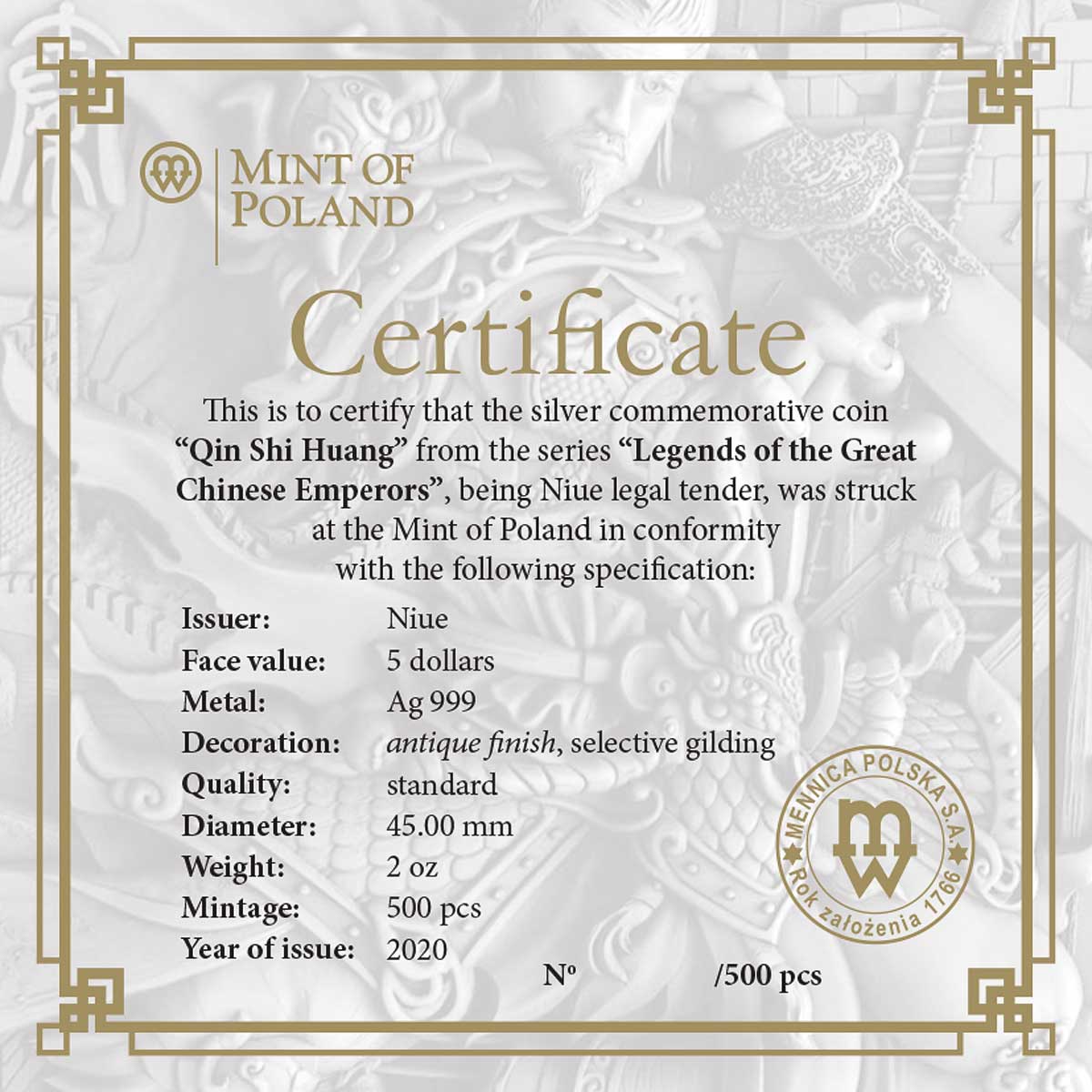The Mint of Poland’s dive into Asian culture continues with a new coin in their signature 2oz ultra high relief range. The series is called ‘Legends of the Great Chinese Emperors’ and as the title suggests, features a non-historical look at genuine figures from the formative years of this ancient state.
First out of the Heavenly Gate is the famous first emperor of China, Qin Shi Huang, founder of the short-lived Qin Dynasty that gave China its name. His legacy includes one of the most well known archaeological sites in the world, the incredible Terracotta Army, part of a mausoleum complex of gigantic proportions, that to date, has still not been fully uncovered.
The coin carries the artistic style set by similar coins from the Mint of Poland themed around the same region, like Chinese Heroes, Four Heavenly Kings, and Famous Chinese Warriors. Hugely dynamic poses, action-packed backgrounds and a single highlighted element, in this case a gilded sword, have all become de rigueur. This new issue ticks all the boxes and does so with the same fantastically high quality that the mint has become known for. It’s one of the more impressive issues for me, although obviously every collector will have their own favourites.
The obverse is very similar in style to some of the other series, but that doesn’t take away from the general attractiveness of it. We’re big fans of coins integrating the required effigy of Queen Elizabeth II into a larger design, rather than having her mugshot cover the whole face. As you’d expect, a nice box with a Certificate of Authenticity is included, and there’s a mintage of 500 pieces. Another fine release to add to one of the best bodies of coins on the market today. This one is distributed by Pela Coins.
THE FIRST EMPEROR OF CHINA
Despite ruling for just over a decade from 221 BC to 210 BC, Qin Shi Huang (Chinese: 秦始皇; lit.: ‘First Emperor of Qin’) has had an impact on China’s history that remains to this day. Born on 18 February 259 BCE with the name Yíng Zhèng (嬴政) or Zhào Zhèng (趙政), he undertook to bring into a single entity all of the smaller warring states that made up the region at the time.
He became King Zheng of Qin in 246 BCE at the age of just 13, assuming full power 9 years later after a time when Qin was fighting with six other states. In 230 BCE the campaign to unite the different states started, and was completed in 221 with the fall of Qi. The Qin Dynasty now ruled over the unified state, eschewing the title of ‘king’ and instead choosing to call himself “emperor” (皇帝 huángdì), a title that remained in use for two millennia.
His reign was a busy one. The campaign to expand the new Empire’s borders began, and he implemented a series of economic and political reforms aimed at stabilisiation and standardisation, to make the new Empire easier to control. Weights, measures and the Chinese script were all made the same, and hereditary regional control was replaced ny one based on merit. Books and education was limited as he believed a less enlightened populace would be easier to control. The Great Wall of China began to take a more unified form under his rule.
However, his most remarkable achievement will forever be his tomb. The world famous Terracotta Army that protects a huge tomb complex, was constructed by the man out of a fear of death. It’s believed he spent years searching for the secret of immortality, but like everyone else, his time came. What remains is a staggeringly complete look back at the world of Qin Shi Huang. His actual tomb has yet to be opened, and is believed to be in a relatively complete condition.
| SPECIFICATION | |
| DENOMINATION | $5 NZD (Niue) |
| COMPOSITION | 0.999 silver |
| WEIGHT | 62.2 grams |
| DIMENSIONS | 45.0 mm |
| FINISH | Antique |
| MODIFICATIONS | Ultra high-relief, Gilding |
| MINTAGE | 500 |
| BOX / C.O.A. | Yes / Yes |






Leave A Comment